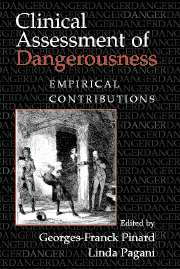Book contents
- Frontmatter
- Contents
- Contributors
- Prologue
- Introduction
- Basic Issues in Violence Research
- Mental Health Issues and Dangerousness
- Family Issues and Dangerousness
- Individual Characteristics and Dangerousness
- 11 Alcohol and Dangerousness
- 12 Violence and Substance Abuse
- 13 Threats, Stalking, and Criminal Harassment
- Conclusion
- Index
13 - Threats, Stalking, and Criminal Harassment
Published online by Cambridge University Press: 03 July 2009
- Frontmatter
- Contents
- Contributors
- Prologue
- Introduction
- Basic Issues in Violence Research
- Mental Health Issues and Dangerousness
- Family Issues and Dangerousness
- Individual Characteristics and Dangerousness
- 11 Alcohol and Dangerousness
- 12 Violence and Substance Abuse
- 13 Threats, Stalking, and Criminal Harassment
- Conclusion
- Index
Summary
I have had my life verbally threatened on several occasions. The most serious threat, and the most frightening, involved a paranoid schizophrenic and psychopathic patient whom I testified against and played a role in his recommitment. I received word that he was attempting to have me killed by paying a third party a sum of money – a conspiracy to murder – but fortunately, his funds were quite limited, although his potential employees were not.
I was neither approached nor attacked in any of these threat situations. They were, as expected, all false positives; but for me the affective memories remain. As Shakespeare wrote, “between the acting of a dreadful thing and the first motion, all the interim is like a phantasma, or a hideous dream” (Julius Caesar, II, i).
Threats against clinicians do occur (Flannery, Hanson, & Penk, 1995; Lion, 1995), and are varied in their frequency, intensity, and meaning. Unfortunately the threat literature appears minuscule when compared to the ubiquity of expressed threats in society. In this chapter I will first focus on articulated threats in the context of the chronically intrusive and sometimes violent behavior of stalking or criminal harassment. Current knowledge of the latter acts will then be summarized to suggest a clinical framework for violence risk assessment and define future research needs.
Definitions
A threat is a written or oral communication that implicitly or explicitly states a wish or intent to damage, injure, or kill the target.
- Type
- Chapter
- Information
- Clinical Assessment of DangerousnessEmpirical Contributions, pp. 238 - 257Publisher: Cambridge University PressPrint publication year: 2000
- 9
- Cited by



